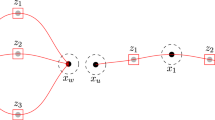Abstract
We show that two complexity classes introduced about two decades ago are unconditionally equal. ReachUL is the class of problems decided by nondeterministic log-space machines which on every input have at most one computation path from the start configuration to any other configuration. ReachFewL, a natural generalization of ReachUL, is the class of problems decided by nondeterministic log-space machines which on every input have at most polynomially many computation paths from the start configuration to any other configuration. We show that ReachFewL = ReachUL.
Similar content being viewed by others
References
Eric Allender (2006) NL-printable sets and nondeterministic Kolmogorov complexity. Theoretical Computer Science 355(2): 127–138
Eric Allender, Klaus-Jörn Lange (1998) RUSPACE(log n) \({\subseteq}\) DSPACE(log2 n/ log log n). Theory of Computing Systems 31: 539–550
Eric Allender, Klaus Reinhardt & Shiyu Zhou (1999). Isolation, Matching, and Counting Uniform and Nonuniform Upper Bounds. Journal of Computer and System Sciences 59(2), 164–181. ISSN 0022- 0000.
Carme Àlvarez, Birgit Jenner (1993) A very hard log-space counting class. Theoretical Computer Science 107: 3–30
Sanjeev Arora & Boaz Barak (2009). Computational Complexity - A Modern Approach. Cambridge University Press. ISBN 978-0-521- 42426-4.
Chris Bourke, Raghunath Tewari, Vinodchandran N. V. (2009) Directed Planar Reachability Is in Unambiguous Log-Space. ACM Transactions on Computation Theory 1(1): 1–17
Gerhard Buntrock, Carsten Damm, Ulrich Hertrampf, Christoph Meinel (1992) Structure and Importance of Logspace- MOD Class. Mathematical Systems Theory 25(3): 223–237
Gerhard Buntrock, Lane A. Hemachandra, Dirk Siefkes (1993) Using Inductive Counting to Simulate Nondeterministic Computation. Information and Computation 102(1): 102–117
Gerhard Buntrock, Birgit Jenner, Klaus-Jörn Lange & Peter Rossmanith (1991). Unambiguity and fewness for logarithmic space. In Proceedings of the 8th International Conference on Fundamentals of Computation Theory (FCT’91), Volume 529 Lecture Notes in Computer Science, 168–179. Springer-Verlag.
Michael L. Fredman, János Komlós, Endre Szemerédi (1984) Storing a Sparse Table with O(1) Worst Case Access Time. Journal of the ACM 31(3): 538–544
Klaus-Jörn Lange (1997). An Unambiguous Class Possessing a Complete Set. In Proceedings of the 14th Annual Symposium on Theoretical Aspects of Computer Science (STACS’97), 339–350.
A. Pavan, Raghunath Tewari & N. V. Vinodchandran (2010). On the Power of Unambiguity in Logspace To appear in Computational Complexity.
Klaus Reinhardt & Eric Allender (2000). Making nondeterminism unambiguous. SIAM Journal on Computing 29(4), 1118 – 1131. ISSN 0097-5397.
Thomas Thierauf & Fabian Wagner (2009). Reachability in K 3,3- Free Graphs and K 5-Free Graphs Is in Unambiguous Log-Space. In Proceedings of the 26th International Conference on Fundamentals of Computation Theory (FCT’09), 323–334.
Author information
Authors and Affiliations
Corresponding author
Rights and permissions
About this article
Cite this article
Garvin, B., Stolee, D., Tewari, R. et al. ReachFewL = ReachUL. comput. complex. 23, 85–98 (2014). https://doi.org/10.1007/s00037-012-0050-8
Received:
Published:
Issue Date:
DOI: https://doi.org/10.1007/s00037-012-0050-8




